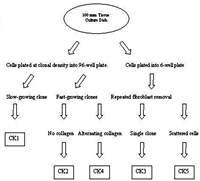The Metabolism of the Pancreas Carcinogen N-nitrosobis(2-oxopropyl)Amine by Hamster Pancreas Duct Epithelial Cell Clones; Evidence for Different Metabolic Efficiencies and Response to Cytochrome P450 Inducers
Abstract
Context We have isolated five stable clones from a primary culture of Syrian golden hamster pancreatic duct epithelial cells and have designated them as CK1 through CK5. Design Here we describe the ability of two of these, CK1 and CK5, to metabolize the pancreas carcinogen N-nitrosobis(2-oxopropyl)amine. The metabolism was assessed as the production of mutated V79 cells in a CK cell/V79 co-culture set up. Results At a dose of 0.1 mM N-nitrosobis(2-oxopropyl)amine, the CK1 cells produced 82.3 ± 17.2 mutants/106 survivors while the CK5 cells produced only 33.2 ± 10.8 mutants/106 survivors, both are mean ± SD (n = 8). Furthermore, both cell types responded differently to two inducers of cytochrome P450 activity, namely Arochlor 1254 and EtOH. Arochlor 1254 treatment did not affect the metabolizing ability of CK1 cells while EtOH treatment resulted in a twofold increase in the mutation frequency. Arochlor and EtOH treatment inhibited the ability of CK5 cells to metabolize N-nitrosobis(2-oxopropyl)amine. Conclusions These data show that the duct epithelium of the pancreas is a multi-cellular tissue and the different cell types within the epithelium have different abilities to metabolize xenobiotic chemicals.
Image: Flow diagram of the procedure.
Downloads
References
Pour PM, Runge RG, Birt D, Gingell R, Lawson T, Nagel D, et al. Current knowledge of pancreatic carcinogenesis and its relevance to the human disease. Cancer 1981; 47:1573-89. [AN 82001797]
Lawson T, Nagel D, Rogers D. The activation of nitrosamines that are carcinogenic to the pancreas. Int J Pancreatol 1991; 10:9-21. [AN 92098996]
Yang CS, Smith TJ. Mechanisms of nitrosamine bioactivation and carcinogenesis. Adv Exp Med Biol 1996; 387:385-94. [AN 96386483]
Lawson T, Kolar C. Mutation of V79 cells by N-dialkylnitrosamines after activation by hamster pancreas duct cells. Mutat Res 1992; 272:139-44. [AN 93024601]
Lawson T. Mutagenicity in V79 cells of N-nitrosobis(2-hydroxypropyl)amine and N-nitrosobis(2-oxopropyl)amine activated by tissues from hamsters fed low and high fat diets. Carcinogenesis 1992; 13:223-6. [AN 92154782]
Lawson T, Kolar C. Mutagenicity of heterocyclic amines when activated by pancreas tissue. Mutat Res 1994; 325:125-8. [AN 95089796]
Heimann TG, Githens SR. Rat pancreatic duct explants cultured in serum free medium on a porous support coated with extracellular matrix. Pancreas 1991; 6:514-21. [AN 92052046]
Kolar C, Lawson T. Mutagenicity of carcinogenic nitrosamines when activated by hamster and human pancreatic duct epithelial cells. Cancer Lett 1997; 117:149-54. [AN 98018384]
Amanuma T, Mizumoto K, Tsutsumi M, Tsujiuchi T, Kitazawa S, Hasegawa K, et al. Initiating activity of diethylnitrosamine in a rapid production model for pancreatic carcinomas in Syrian hamsters. Jpn J Cancer Res 1991; 82:632-7. [AN 91310488]
Tsao M, Earp HS, Grisham JW. Gradation of carcinogen-induced capacity for anchorage-independent growth in cultured rat liver epithelial cells. Cancer Res 1985; 45:4428-32. [AN 85282332]
Tsao M, Duguid WP. Establishment of propagable epithelial cell lines from normal adult rat pancreas. Exp Cell Res 1987; 168:365-75. [AN 87105661]
Nagel D, Kupper R. Synthesis of 14C-labeled N-nitrosobis(2-oxopropyl) amine. J Labeled Cpds Radiopharm 1971; 18:1081-5.
Jenssen D. A quantitative test for mutagenicity in V79 Chinese hamster cells. In: Kilbey BJ, Legator M, Nichols W, Ramel C, eds. Handbook of mutagenicity test procedures. Amsterdam: Elsevier Science Publishers, 1984; 269-90.
Gad S, Weil CS. Statistics and experimental design for toxicologists. Caldwell NJ, USA: The Telford Press, 1986: 70-92.
Schmied B, Liu G, Moyer MP, Hernberg ISB, Sanger W, Batra S, et al. Induction of adenocarcinoma from hamster pancreatic islet cells treated with N-nitrosobis(2-oxopropyl)amine in vitro. Carcinogenesis 1999; 20:317-24. [AN 99167001]
Nagel DL, Lewis R, Fisher M, Stansbury K, Stepan K, Lawson T. Beta-oxidized N-nitrosoalkylcarbamates as models for DNA alkylation by N-nitrosobis(2-oxopropyl)amine in Syrian hamsters. IARC Sci Publ 1987; 84:71-4. [AN 88057406]
Phillipson CE, Ioannides C, Parke DV. Metabolic activation of dimethylnitrosamine to mutagens: role of cytochromes P-450 and P-448. Toxicol Lett 1982; 11:95-101. [AN 82224828]
Rendic S, Di Carlo FJ. Human cytochrome P450 enzymes: A status report summarizing their reactions, substrates, inducers, and Inhibitors. Drug Metab Rev 1997; 29:413-580. [AN 97331196]
Kessova IG, Decarli LM, Lieber CS. Inducibility of cytochromes P-4502E1 and P-4501A1 in the rat pancreas. Alcohol Clin Exp Res 1998; 22:501-4. [AN 98240791]
Lawson T, Kolar C, Reyes T. Mutagenicity of 2-amino-1-methyl-6- phenylimidazo[4,5-b]pyridine (PhIP) when activated by hamster pancreatic duct epithelial cells: A chemopreventive role for glutathione. Mutat Res 1997; 375:73-8. [AN 97275919]
OinonenT, Lindros KO. Zonation of hepatic cytochrome P-450 expression and regulation. Biochem J 1998; 329:17-35. [AN 98070203]

Copyright (c) 2000 Carol Kolar, Terence Lawson

This work is licensed under a Creative Commons Attribution 4.0 International License.
As a member of Publisher International Linking Association, PILA, iMedPub Group’s JOP follows the Creative Commons Attribution License and Scholars Open Access publishing policies. Journal of the Pancreas is the Council Contributor Member of Council of Science Editors (CSE) and following the CSE slogan Education, Ethics, and Evidence for Editors.